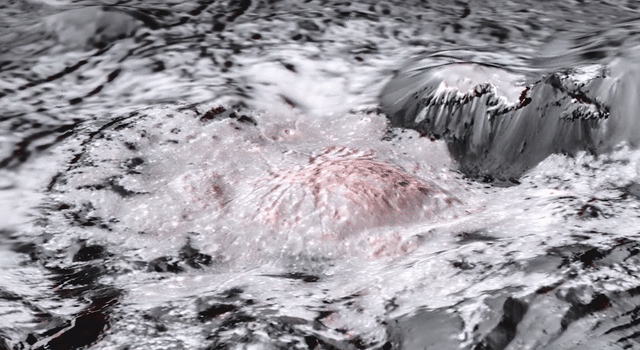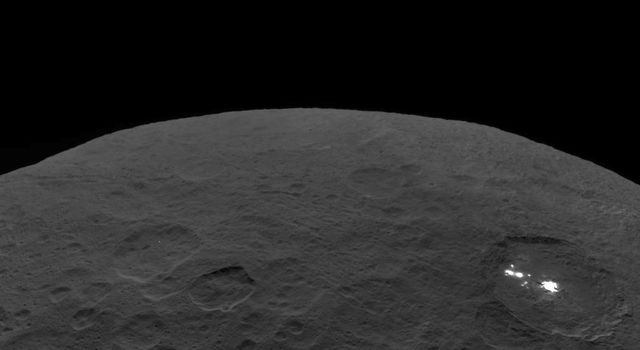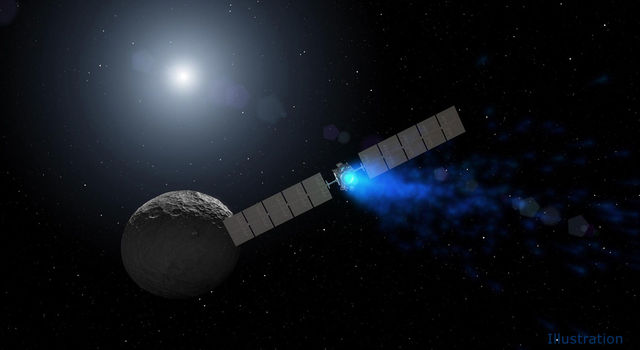Blogs | Dawn Journal | August 31, 2016
Dear Sedawntary Readers
Dawn is actively continuing to add details to the intimate portrait it is creating of Ceres, a distant and exotic world.
The dwarf planet has been revealing many secrets to the companion she has held in her tender but firm gravitational embrace since early last year.
Following the conclusion of Dawn's ambitious 8.8-year prime mission on June 30, the spacecraft has been gathering a wealth of data with all sensors in its extended mission as it orbits closer to Ceres than the International Space Station is to Earth. When the adventurer descended to its current orbital altitude of 240 miles (385 kilometers) in December 2015, mission controllers had planned for only a few months of operations. Because of the prior failure of two reaction wheels, used for orienting the craft in space, Dawn had to rely on the creativity of the team to stretch the dwindling supply of hydrazine to keep the ship operating. No one on the team expected their efforts to be as productive as they turned out to be, allowing the mission to continue much longer. Now Dawn has completed more than eight months of virtually flawless activities at this altitude, over 1,100 orbital revolutions, returning far, far more data than ever anticipated.
We have recounted in recent months how Dawn has overachieved, and its extended mission has sustained that favorable trend. As just one example, since Ceres first showed up as a small, fuzzy blob in Dawn's camera in December 2014, the spacecraft has taken more than 51,000 photos of Ceres (and more than 51,000 more photos of Ceres than discoverer Giuseppe Piazzi took). More than 37,000 of those have been taken in this fourth and lowest orbit, providing exquisite resolution.
Dawn has achieved so much that it has been given new, special assignments not even envisioned at the beginning of this year. For example, scientists recently adjusted settings for the gamma ray spectrometer to search for the signature of atoms that were not part of the original program of inventorying Ceres' elements.
The reason for flying so low was to measure nuclear radiation and the variations in the gravity field. In fact, Dawn was not designed to map the vast territory with its other instruments from this tight orbit. All the pictures, infrared spectra and visible spectra have been bonuses of a successful mission. We have seen before how difficult it was to capture specific geological features on Ceres with the camera. It is even more challenging with the visible and infrared mapping spectrometers because they share a much narrower view than the camera. Nevertheless, with great effort, the team managed in the extended mission to obtain beautiful spectra of the famous bright region in Occator Crater, known from earlier spectra to be highly reflective deposits of salt left behind when briny ice covering the ground inside the crater sublimated. Dawn has been successful in tracking down other important sites with its visible and infrared spectrometers as well.
After photographing more than 99.9 percent of the dwarf planet at high resolution, the spacecraft took a great many more pictures at different angles, making stereo views to improve the topographical map it developed in the third mapping orbit. In addition, Dawn used the filters in its camera to take new, sharper color photos of some of the most geologically interesting locations.
The explorer has acquired other pictures of special scientific interest as well. Let's delve into one kind. We have described Dawn's findings about the location of the north and south poles and the tilt of Ceres' rotational axis. As we saw, Earth's axis is tilted more, so our planet experiences greater variation in the position of the sun during one heliocentric revolution (one year). On Ceres, the sun never moves far from the equator, which means it is always far from the poles. From the perspective of the high northern or southern latitudes, the sun is always near the horizon and is never high in the sky. As a result, the floors of some craters near the poles are in shadow continuously throughout the Cerean year (which lasts 4.6 terrestrial years). Without even brief warming rays of the distant sun, these locations must be especially cold.

Thanks to Dawn, we know ice has been on the ground in some places in the past and is there even now in Oxo Crater. (We also know there is a tremendous amount of ice underground.) When ice on the surface is heated enough by the sun, it sublimates, the water molecules receiving enough energy to escape from the solid, becoming a gas. Some of them leave with so much energy, they break free of Ceres' gravitational pull and go far into space. But many of the molecules follow a familiar parabolic arc, landing elsewhere on the dwarf planet, just as a ball thrown on Earth will come back down. If the landing spot is similarly warm enough for ice to sublimate (as most places on Ceres are), eventually the molecule will be lofted again, having a chance of landing in a new, random location. But molecules that happen to fall in the deep cold of a crater in persistent shadow will be trapped. As a result, these "cold traps" may harbor ice that has accumulated over thousands of years (or even longer).
Dawn has peered into craters that might be cold traps. Of course, sunlight doesn't illuminate them directly. But faint reflections from other parts of the crater may be just barely bright enough that with long exposures and special care in analyzing the pictures, new insights might come to light.
Dawn could continue operating in this orbit, but it has already squeezed nearly as much out of its suite of sophisticated sensors as it can, and it soon would reach the point of diminishing returns. In addition, its lifetime here is now very limited. Although the hydrazine has lasted longer than expected, the gauge on the tank is dropping relentlessly as the robotic ship uses the propellant to counter the strong gravitational torque at this low altitude. Even if the two functioning reaction wheels continue to run correctly in hybrid control, the hydrazine would be exhausted early next year, and the mission would come to an immediate end. And given the premature death of the other two wheels, Dawn might not last even that long. If one more wheel fails, Dawn's remaining lifetime would be cut in half. At this point, how can we get the most out of Earth's deep-space ambassador?

We have explained before that Dawn will never go closer to Ceres. There are several reasons. The rate at which hydrazine is consumed depends quite strongly on the altitude, so if the probe ventured lower, its lifetime would be significantly shorter. (Similarly, at higher altitude, it uses less hydrazine and so its lifetime would be longer.) Ceres has water (albeit mostly frozen, although perhaps some as liquid), energy (both from the distant sun and from radioactive elements incorporated when Ceres formed more than 4.5 billion years ago), and some of the other important ingredients for the development of life. We want to protect this astrobiologically interesting environment from the spacecraft's terrestrial contamination, so we cannot risk going low enough that it might crash, even long after the mission concludes. (And a controlled landing is not possible.) Also, at lower altitudes Dawn would orbit so fast that pictures and other measurements would be smeared, reducing the benefit of being closer. There are other reasons as well, but the bottom line is that this orbit is where Dawn draws its bottom line.
Ever creative, the team has found new ways to increase the mission's scientific productivity. Once again, the strategy involves changes never anticipated and that may be contrary to what your intuition would suggest. For more than two years, your correspondent has been emphasizing that this would be Dawn's final orbit. Now, on Sept. 2, Dawn will begin flying to a higher altitude.
The prospect of raising the orbit also raises several natural questions about what will happen in the coming months, including how, why and what kind of cake will be served at the team's celebration on Sept. 27 of the ninth anniversary of Dawn's launch. This month, let's look at how, and as the team refines its plans for the other key questions, we will discuss the answers in future Dawn Journals.
To gain altitude, Dawn will take advantage of its remarkable ion propulsion system. Ion propulsion has enabled many bold missions from Star Trek to Star Wars to NASA's unique expedition to orbit Vesta and Ceres, which would have been not simply difficult but impossible with conventional propulsion. And like the spaceships that in science fiction fly wherever they want to go, now Dawn will use its xenon ions to maneuver to an orbit it would not otherwise be able to reach. (Despite the similarity, there are some ways in which Dawn differs from the fictional ships: our craft uncompromisingly obeys all the laws of physics and carries relatively few systems designed to destroy other ships in battle.)

To climb higher, Dawn will essentially reverse the spiral route it took down to its current orbit, much as it did when it ascended from Vesta. (There are some interesting technical differences in the nature of this trajectory from all of the other spirals. The design incorporates clever new ideas from Dawn's celestial navigators. But to the casual interplanetary observer, it will appear the same.) As with all of Dawn's activities, you can follow its progress upward with the mission status updates.
After five weeks of ion thrusting, looping higher and higher, the spacecraft will stop at about 910 miles (1,460 kilometers). Readers with eidetic memories (or who reread past Dawn Journals) may note that that is very close to the altitude of the third mapping orbit. However, the orientation of the orbit will be different. The spaceship will still circle in a polar orbit. It will travel over the north pole, then fly south above the face of Ceres lit by the sun. After it passes over the south pole, it will streak to the north over terrain hidden in the dark of night. But the plane of this orbit will be rotated from that of the third mapping orbit. The angle to the sun will be larger, so Dawn will pass over a different part of the sunlit hemisphere, gaining new perspectives on the extraterrestrial landscapes.
At its current low altitude, Dawn is now completing a truly extraordinary phase of its exploration of Ceres. But there is still much more to come, with new scientific investigations, new discoveries and new adventures at higher altitudes. Now that we have seen a little of the how, be sure to look for upcoming Dawn Journals to learn more about the why (and about the anniversary cake).
Dawn is 240 miles (385 kilometers) from Ceres. It is also 2.24 AU (208 million miles, or 335 million kilometers) from Earth, or 855 times as far as the moon and 2.22 times as far as the sun today. Radio signals, traveling at the universal limit of the speed of light, take 37 minutes to make the round trip.
Dr. Marc D. Rayman
4:00 p.m. PDT August 31, 2016







